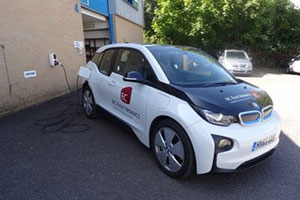It’s been a long time coming, but electric cars are finally set to make a breakthrough…
EC Electric Car
2020 is expected to be the year when they become a realistic option for most new car buyers. In fact, by the end of the year, an estimated 25 different electrics vehicles will be on sale — from family-style SUVs and high-performance sports cars, right down to a small city run-around.
Manufacturing a more sustainable future
The majority of greenhouse gas emissions in the UK now come from transport, which contributed to 33% of the 2018 total according to government figures. So, the rising popularity of electric cars is excellent news when it comes to cutting back on carbon emissions and saving the planet — a current hot topic of conversation!
In 2017, the UK Government committed to disallowing the sale of new petrol and diesel vehicles by 2040. Then in June earlier this year, the UK became the first major economy in the world to pass laws to end its contribution to global warming. These laws will require the country to bring all greenhouse gas emissions to zero by 2050.
When it comes to meeting these climate targets, adopting more eco-friendly cars is a vital part of the puzzle.
Improvements on the horizon
Other than sustainability, there are a number of benefits associated with switching to electric vehicles. Firstly, with the ever-rising price of petrol, electric cars offer a much more cost-effective solution — plus, they’re exempt from emissions charges and vehicle tax too.
The purchase price of electric cars is also just about coming down to more affordable levels, while the increasing supply of vehicles is improving the selection of used models available.
improving the selection of used models available.
Until recently, the only major downside to electric cars was the lack of charging locations around the UK. But this all looks likely to change in the near future.
There have been talks of charging lanes, which would enable drivers to wireless charge their vehicles while driving across a specially made road. Equally, some energy providers are already offering charging solutions for businesses, such as retailers and hotels chains, in their car parks — helping to satisfy the increase in demand.
As part of the efforts to achieve zero emissions by 2050, the government is also looking at plans for all new homes to have electric charging points for cars. Homes like these, which help residents to reduce their carbon footprint, are growing rapidly in demand.
Same same, but different
While this may all sound somewhat futuristic, electric cars look a lot like conventional ones from the outside. Tesla has long been leading the way in the market, but its models tend to be on the pricier end of the scale and have often been thought too ambitious for most car buyers.
However, a number of the mainstream car manufacturers — such as Nissan, Hyundai, Renault, BMW, Audi and Jaguar — are now also starting to introduce electric cars to their ranges. Top Gear recently did a roundup of their top 10 everyday electric cars from these brands.
But although they may look the same from the outside, look inside and you’ll see they’re an entirely new breed of automobile. So, what makes these exciting new developments possible? Electronics of course!
In an electric car, you’ll find several key components. For example, instead of the usual fuel cap, these vehicles have a safety socket for users to plug an electrical cable into. This high-voltage cable then connects the charging socket to the lithium-ion battery (which is controlled by a special battery management system, often via a smartphone) and allows power to flow.
How much charge a battery holds and for how long will depend on its size and efficiency, but most will keep going for around 100 miles. Power electronics then ensure the flow of energy is delivered as a constant, steady supply rather than in one big burst.
As manufacturers and developers, it is our responsibility to ensure trends such as technology and sustainability are at the forefront of the projects we work on. Which is why we always make sure we’re up to date with the latest advancements in electronics, such as the rise of innovations like electric cars.






